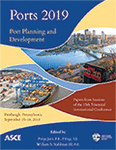15th Triennial International Conference
A New Berth for Halifax
Publication: Ports 2019: Port Planning and Development
ABSTRACT
The Port of Halifax, Nova Scotia, is Canada’s primary Atlantic gateway. With sheltered deep water on the great circle route between Northern Europe and New York, excellent rail connections to Central Canada, and high cargo demand on the North Atlantic seaboard, there is clear potential for Halifax to increase its container traffic. However, the future success of Halifax hinges on its ability to increase capability for serving ultra-class container vessels (UCCVs). One of Halifax’s two main container terminals is on Fairview Cove, north of two suspension bridges that prevent UCCV passage. To increase its big ship capability, the Halifax Port Authority must expand its berth space south of the bridges. New berth developments must respect a wide range of constraints in Halifax’s rich urban fabric, including parks, housing, historic monuments, and cruise facilities. For example, lengthening the existing berth at the south container terminal (SCT) is an apparent engineering solution; however, the view from Halifax’s beautiful and historic Point Pleasant Park, which sits immediately inland from the existing berth, would be adversely impacted. Expansion of SCT capacity also could increase congestion on Halifax’s narrow downtown streets, through which half of SCT’s traffic flows. Any capacity augmentations must be planned to avoid further degradation of access to Halifax’s vibrant commercial core. A port master planning effort started with an unconstrained examination of all possible solutions to both berth placement and landside transport improvements. High level berth alternatives included extensions, re-alignments, and relocations within the existing SCT, and replacing SCT with a new “bluefield” terminal. Landside alternatives to improve transportation included the use of short-haul barges, short-haul inter-terminal rail shuttles, a new dual-mode road/rail arterial, a new tunnel to divert trucks, an inland rail yard to decrease downtown truck traffic, and a new terminal located elsewhere in the harbor to shift operations away from Halifax. The Master Plan Team conducted extensive stakeholder outreach to identify all potential alternatives. Terminal and landside connection plans were developed for four major strategic alternatives. Close consultation with regional rail, road, and maritime stakeholders focused on refining each alternative’s logistical and operational flows. Technical experts in cruise operations, park facilities, dry bulk cargo handling, deep tunneling, bridge construction, real estate valuation, airfield clearance, rail operations, oil terminals, navigation, and site remediation were engaged to resolve specific technical issues for each alternative. Conceptual cost estimates and benefits of each alternative were thoroughly explored. A viable solution for both berthing and inland transport issues was identified and is being implemented by the HPA. The paper will explore how the various available alternatives were identified, evaluated, and resolved into a workable port master plan (PMP) for Halifax.
Get full access to this article
View all available purchase options and get full access to this chapter.
Information & Authors
Information
Published In
Ports 2019: Port Planning and Development
Pages: 243 - 255
Editors: Pooja Jain, Moffatt & Nichol and William S. Stahlman III, America's Central Port
ISBN (Online): 978-0-7844-8262-9
Copyright
© 2019 American Society of Civil Engineers.
History
Published online: Sep 12, 2019
Published in print: Sep 12, 2019
Authors
Metrics & Citations
Metrics
Citations
Download citation
If you have the appropriate software installed, you can download article citation data to the citation manager of your choice. Simply select your manager software from the list below and click Download.
